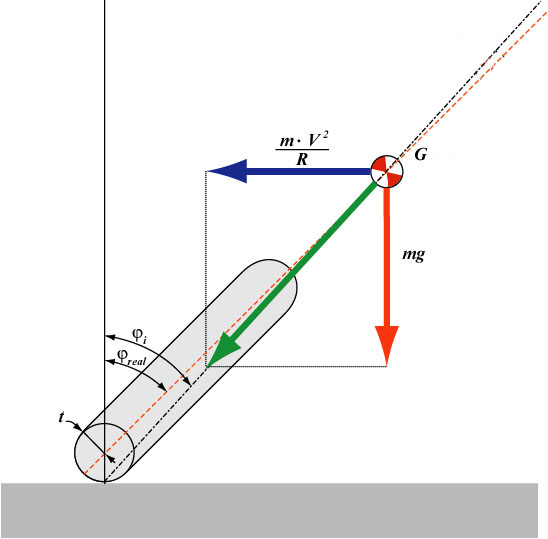Turning and Leaning a Motorcycle 5/1/2006

Above is a free body diagram of the forces in play when you lean and turn your
bike. The green vector is
product of two forces acting through the center of mass of the bike and rider
through the contact point of
the tire. The vertical component (red), is due to gravity (mg), and the
horizontal component (blue), is due to
centripetal forces (m * V^2)/R from turning. You can determine the angle of lean
for a given turn radius and
speed by summing moments of the forces around the tire contact point. As you can
see from the diagram, the
actual angle of the bike is slightly more than the angle from the center of mass
to the contact point.
Now, this diagram assumes the center of mass of the bike and the rider are
aligned. This is probably rarely the case
and will be addressed below. But, in the case where you are riding upright (not
hanging off the side of the bike), the
angle is constant for a given speed, turn radius and height of mass. You can
change the angle for a given speed and turn
radius by changing the height of the center of mass. This has no effect if you
are leaned at 45 degrees because raising
or lowering the center of mass will move it an equal distance both horizontally
and vertically from the tire
contact point. But, if you are leaned over less than 45 degrees, raising your
center of mass will increase the overturning
caused by centripetal forces more quickly than the moment due to gravity,
requiring you to lean further to make the same turn.
Crouching down has the opposite effect. Your required lean angle from vertical
will be reduced as you lower you center of mass.
Since your mass is separate from that of the bike, you can effect the system
above by shifting you weight in either direction
relative to the center of the bike. But, the forces acting on the complete
system are still the same. That is, the lean angle
calculated for a given speed, turn radius and height of mass remain constant and
act through the center of mass of the
composite mass of the bike and rider. If you hang to the inside of the turn, you
will actually have to push the bike more
vertical to keep the composite center of mass at a constant location for the
speed and turn radius. Conversely, if you
lean to the outside of the turn you will actually have to lean the bike further.
This is consistent with the experience of
many riders I've spoken with.
In a racing situation you can do two things to carry more speed through a
turn.
1. Lowering the riders weight would allow you to either decrease the lean
angle for a given speed and turn radius, increase the speed for a constant lean
angle and turn radius, or tighten the corner for a given speed and lean angle.
2. Shifting you weight to the inside of the turn also gives you the same
options. You will increase you peg clearance if you
remain at the same speed and turn radius. You can either increase your speed or
tighten the turn if you keep the same lean
angle.
In any of these cases the same free body diagram above can be used to
calculate the lean angle to the center of mass
if you know it's location, and the speed and radius of the turn.
Adam
Return to Motorcycle links page.
